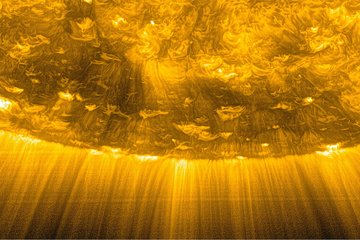All genres
21.
Journal Article
Daytime scintillations induced by high-power HF waves at Tromsø, Norway. Journal Geophysical Research 92, pp. 11149 - 11157 (1987)
22.
Journal Article
Propagation of artificially excited Langmuir waves in the ionosphere. Radio Science 22, pp. 655 - 661 (1987)
23.
Journal Article
The characteristics of ionospheric heating-produced ELF/VLF waves over 32 hours. Journal Geophysical Research 92, p. 8707 (1987)
24.
Journal Article
ELF and VLF signals radiated by the ``Polar Electrojet Antenna'': Experimental results. Journal Geophysical Research 91, pp. 4451 - 4459 (1986)
25.
Journal Article
ELF and VLF signals radiated by the "Polar Electrojet Antenna": experimental results. Journal Geophysical Research 91, pp. 4451 - 4459 (1986)
26.
Journal Article
Comparison between the ionospheric plasma drift and the motion of artificially induced irregularities as observed by HF backscatter radars. Annales Geophysicae 4, p. 49 (1986)
27.
Journal Article
Measurements of HF backscatter cross section for striations created by ionospheric heating at different power levels. Radio Science 21, pp. 117 - 125 (1986)
28.
Journal Article
Heater-induced 1-meter irregularities. Journal Geophysical Research 91, p. 11309 (1986)
29.
Journal Article
EISCAT observations of the heated ionosphere. Journal of Atmospheric and Terrestrial Physics 48, pp. 1027 - 1035 (1986)
30.
Journal Article
D-region characteristics deduced from pulsed ionospheric heating under auroral electrojet conditions. Journal of Atmospheric and Terrestrial Physics 48, pp. 311 - 326 (1986)
31.
Journal Article
Extra-low frequency radiation from the polar electrojet antenna. Nature 317, p. 6033 (1985)
32.
Journal Article
ELF radiation from the polar electrojet antenna. Nature 317, pp. 155 - 157 (1985)
33.
Journal Article
The diffraction of VLF radio waves by a patch of ionosphere illuminated by a powerful HF transmitter. Journal Geophysical Research 90, pp. 2861 - 2875 (1985)
34.
Journal Article
Observations of E-region irregularities generated at auroral latitudes by a higher-power radio wave. Journal Geophysical Research 90, p. 12293 (1985)
35.
Journal Article
HF modification of the auroral D-region detected by a partial reflection experiment. Journal of Atmospheric and Terrestrial Physics 47, pp. 537 - 545 (1985)
36.
Journal Article
HF modification of the auroral d-region detected by a partial reflection experiment. Journal of Atmospheric and Terrestrial Physics 47, pp. 537 - 545 (1985)
37.
Journal Article
Ionospheric modification experiment with the Tromsø heating facility. Journal of Atmospheric and Terrestrial Physics 47, p. 1151 (1985)
38.
Journal Article
Ionospheric modification experiments with the tromsØ heating facility. Journal of Atmospheric and Terrestrial Physics 12, pp. 1151 - 1163 (1985)
39.
Journal Article
Effect of a heated patch of auroral ionosphere on VLF-radio wave propagation. Nature 309, pp. 534 - 536 (1984)
40.
Journal Article
First experimental evidence of HF produced electron density irregularities in the polar ionosphere, diagnosed by UHF radio star scintillations. Geophysical Research Letters 11, pp. 523 - 526 (1984)










